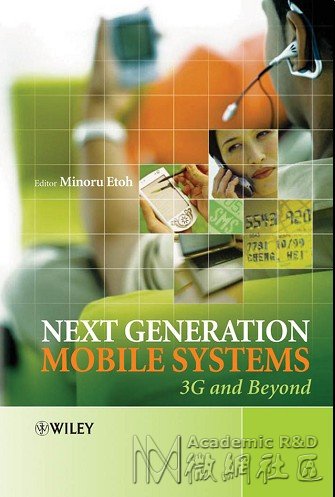Next Generation Mobile Systems
3G and Beyond
Edited by
Minoru Etoh
DoCoMo Communications Laboratories USA
Contents
Foreword
Preface
Acknowledgments
List of Contributors
I A Vision for the Nex
1 Evolution of Mobile Netw
1.1 The Evolution of Mo
1.2 Trends in Mobile Se
1.3 Why Next-generation
1.4 Next-generation Imp
1.4.1 Radio Acces
1.4.2 IP Backbone
1.4.3 Ubiquitous S
2 The All-IP Next-generati
2.1 Introduction....
2.2 3G Architectures.
2.2.1 UMTS..
2.2.2 CDMA2000
2.2.3 MWIF...
2.2.4 Limitations o
2.3 Approach to a Next-
2.3.1 Rationale an
2.3.2 Architecture
2.4 Conclusions....viii
II Overview of Mobile
3 Radio Access Technologi
3.1 Introduction....
3.1.1 Current Radi
3.1.2 Evolving Ra
3.2 Background of Radio
3.2.1 Propagation
3.2.2 Basic Multip
3.2.3 Principles of
3.3 Radio Access Techn
3.3.1 W-CDMA
3.3.2 Spreading Co
3.3.3 Orthogonal M
3.3.4 Turbo Codes
3.3.5 Coherent Ra
3.3.6 Transmission
3.4 High-speed Transmis
3.4.1 Adaptive Mo
3.4.2 Hybrid ARQ
3.4.3 Fast Cell Sel
3.5 Radio Access Techn
3.5.1 Technical Re
3.5.2 Potential Sol
3.5.3 Potential Sol
3.6 Broadband Radio Ac
3.6.1 VSF-OFCDM
3.6.2 VSCRF-CDM
3.7 Conclusions....
4 Wireless LAN Evolution
4.1 Introduction....
4.1.1 Overview of
4.2 Basic Technologies i
4.2.1 MAC Techno
4.2.2 PHY Techno
4.3 Evolution of WLAN
4.3.1 Higher Data
4.3.2 Extended Co
4.3.3 Coexistence
4.3.4 Seamless Mo
4.3.5 Location Est
4.3.6 Differentiated
4.3.7 Quality of Se
4.3.8 Enhanced SeCONTENTS
4.4 Mobility Support.
4.4.1 Fast Channel
4.4.2 Fast Authent
4.5 Quality of Service
4.5.1 EDCA and H
4.6 Security......
5 IP Mobility
5.1 Introduction....
5.2 The Internet Archite
5.2.1 The End-to-e
5.2.2 Internet Arch
5.2.3 IP Addresses
5.2.4 Fully Qualifi
5.3 Network Layer Mob
5.3.1 Basic Mobile
5.3.2 Routing Inef
5.3.3 Mobile IP H
5.3.4 AAA and Se
5.4 Achieving Seamless
5.4.1 Header Com
5.4.2 Context Tran
5.4.3 Intertechnolo
5.4.4 Candidate A
5.5 Summary.....
6 APIs and Application Pl
6.1 Introduction....
6.2 Background....
6.2.1 Service Crea
6.2.2 Service Crea
6.2.3 Service Crea
6.2.4 Types of AP
6.2.5 APIs Versus
6.2.6 Programming
6.3 Standard Telecommu
6.3.1 Parlay...
6.3.2 JAIN...
6.3.3 Open Mobile
6.4 Advanced API Effor
6.4.1 Parlay Web S
6.4.2 Router APIs
6.5 Our Approach...
6.5.1 Layered API
6.5.2 Content Deli
6.6 Discussion and Concx
III Middleware and A
7 Terminal Software Platfo
7.1 Introduction....
7.1.1 Generic Term
7.1.2 Terminal Sof
7.2 Existing Terminal So
7.2.1 Symbian OS
7.2.2 Palm OS.
7.2.3 Windows CE
7.2.4 QUALCOMM
7.2.5 Software Pla
7.3 Runtime Environmen
7.3.1 Sun Java.
7.3.2 Microsoft.N
7.3.3 Benefits of R
7.4 Terminal Software P
7.4.1 TCG Specifi
7.4.2 Trusted Com
7.5 Terminal Software P
7.5.1 Open Mobile
7.5.2 Over the Air
7.6 Research Directions
7.6.1 Terminal Mi
7.6.2 Mervlets:Le
7.7 Conclusions....
8 Multimedia Coding Tech
8.1 Introduction....
8.2 Speech and Audio C
8.2.1 Speech Codi
8.2.2 Principles of
8.2.3 Audio Codin
8.2.4 Speech and A
8.2.5 Further Rese
8.3 Video Coding Techn
8.3.1 Principles of
8.3.2 Video Codin
8.3.3 Video Codin
8.3.4 Further Rese
8.4 Mobile Multimedia A
8.4.1 Mobile TV P
8.4.2 Multimedia M
8.4.3 Future TrendCONTENTS
9 Wireless Web Services
9.1 Introduction....
9.1.1 Emerging W
9.1.2 Web Service
9.1.3 Web Service
9.2 Web Services Archit
9.2.1 Web Service
9.3 Web Service Techno
9.3.1 Communicat
9.3.2 The Base Te
9.3.3 Messages–S
9.3.4 Web Service
9.3.5 Web Service
9.3.6 Web Service
9.3.7 J2ME Web S
9.3.8 Research on
9.4 Web Services and th
9.4.1 Web Service
9.4.2 Location-awa
9.5 Conclusion....
IV Security
10 Cryptographic Algorithm
10.1 Introduction....
10.1.1 The Challeng
10.1.2 Chapter Ove
10.2 Secret-key Cryptogra
10.2.1 Some Histor
10.2.2 GSM...
10.2.3 3GPP and K
10.3 Public-key Cryptogra
10.3.1 Some Histor
10.3.2 Certification
10.3.3 SSL....
10.4 Public-key Infrastruc
10.4.1 Hash-based C
10.4.2 Certificate-ba
10.4.3 Identity-base
10.5 Proving that a Crypt
10.5.1 The Provable
10.5.2 Example:Th
10.6 Advanced Functiona
10.6.1 Electronic Cxii
10.6.2 Coping with
10.6.3 Efficient Cry
10.6.4 Cryptography
10.6.5 Other Resear
10.7 Conclusion....
11 Authentication,Authoriz
11.1 Evolution of AAA
11.2 Common AAA Fram
11.3 Technologies...
11.3.1 RADIUS and
11.3.2 Extensible A
11.3.3 PANA...
11.3.4 WLAN..
11.3.5 IP-based Cel
11.4 Emerging Research
11.4.1 AAA for Ac
11.4.2 802.11i Hand
11.4.3 Unified AAA
12 Security Policy Enforcem
12.1 Introduction....
12.2 Standard Dynamic M
12.2.1 Stack-inspec
12.3 Selective Dynamic M
12.3.1 Wallach et al
12.3.2 Erlingsson an
12.3.3 Evans and Tw
12.3.4 Pandey and H
12.3.5 Kim et al.:L
12.3.6 Chander et a
12.3.7 Ligatti et al.:
12.3.8 Colcombet a
12.4 Static Security Mana
12.4.1 Gosling et al
12.4.2 Morrisett et
12.4.3 Xi:Depende
12.4.4 Crary and W
12.4.5 Necula and L
12.4.6 Sekar et al.:
12.4.7 Xia and Hoo
12.4.8 Fitzgerald et
12.5 Conclusion....
Bibliography
Index
